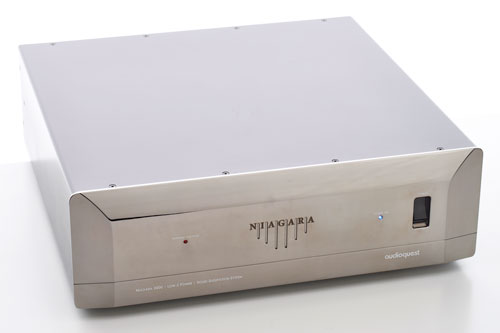From then on we used the mains socket to which the now unused SunLeiste was attached to power the Niagara. The 7000 continued to supply the power amplifier and we began to gradually re-connect the preamplifier, the two (mono) phono preamps, the heater and the tube power supply for the turntable from the PS Audio and the Audioplan distribution box to the Niagara: the improvements were clearly noticeable in the preamplifier and also with the equalizers – but not as strong as in the preamplifier. On the other hand, I was surprised that the tube power supply benefited so clearly from NRG Z and the cleaning effect of Niagara. The bearing heater, however, did not show any sound improvements, so I reconnected its power cord to the PS Audio for further experiments: in this way I could connect the phono preamplifier, the tube power supply and the preamplifier to one group of the Niagara and find out whether the analog playback would be affected by the use of the second group.

Although AudioQuest’s delivery also included the Niagara 1000 with a further six sockets, Robert Hay had only ordered it because the turntable with heater and power supply, the two phono stages and router, switch, NAS, streaming bridge, up-scaler and converter simply required a large number of sockets. I almost forgot about the Studer A80, which also demanded a socket. The AudioQuest specialist considered the separation of analog and digital sources on two network conditioners unnecessary: "The Niagara has two completely separate output groups.” After my previous experiences with the effects of the location of a router on the playback of records, I was extremely skeptical: of course, it was not clear at that time whether the impairments caused by the Apple Time Machine, which was set up very close to the system, would be induced solely by its RF signals or whether they would be transmitted over the mains, despite two filters. Since the use of a linear power supply for the router had a positive effect, I have preferred to be cautious since then and try to separate digital and analog devices as rigorously as possible. As the list of all components involved in the playback of files has already shown, the second group of Niagara's four sockets cannot supply all remaining devices. We therefore fed the M-Scaler from a Poweradd with 23,000 mAh and connected the router, Melco, Aries Femto and DAVE to the 7000 – without listening to them. That’s because the music continued to come from the vinyl record. To my astonishment – and as Robert Hay had predicted – the sound did not change at all when the digital group was added. I then connected the switch again instead of the Melco, didn't just leave it at a test track, connected and disconnected the digital components again. In no case was the record playback affected by what happened to the third group of the Niagara: Garth Powell has succeeded in completely isolating both groups from each other. Respect!
So, if your system requires four sockets for digital equipment and four for preamplifier and analogue, a Niagara 7000 is the ideal solution. Not to forget: thanks to "Power Correction", your power amplifiers or active speakers will work as dynamically as if they suddenly had twice as powerful power supplies. Unfortunately, my system is a little bigger, so there was still a lot of work to do before Robert Hay and I could enjoy the sound improvements of AudioQuest's power cord and conditioners. We unplugged the turntables and phono stages, and reconnected the digital components to the Sonic-Line filter: everything back to baseline. Then we let the converter and co. move to the 7000 one by one. Thanks to the Niagara, the DAVE sounded a bit more open, and the improved current allows the Melco a slightly wider representation of space. Miraculously, the router took it in the same direction when the power flowed through the AudioQuest. The Auralic Aries Femto, which – like the router – is powered by a Sbooster power supply, showed no improvements, neither did the Switch nor the M-Scaler. After this test marathon, it was time to clean up, because according to Robert Hay, it looked like a spaghetti factory had exploded around the stereo. However, I had never seen such thick spaghetti before. But even if it looked chaotic and we hadn't managed to connect the Studer yet, we called it a day and ended up in a Bavarian pub.



























 |
|

















































































